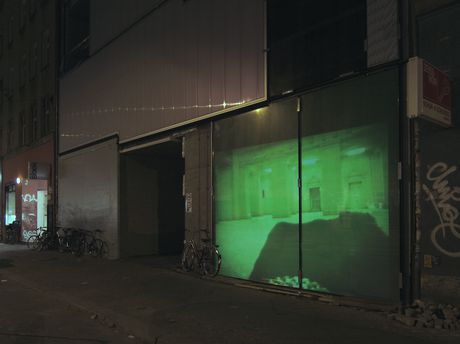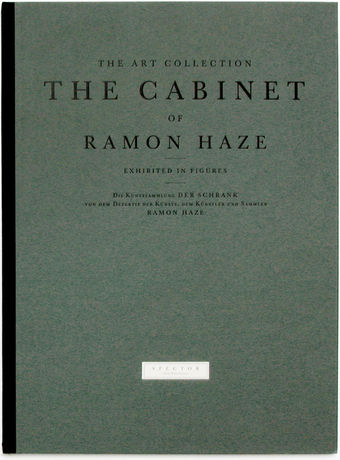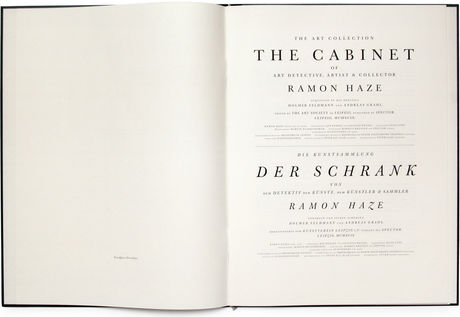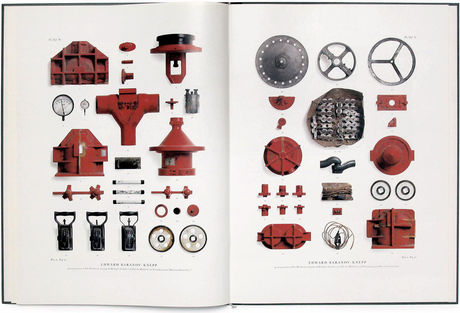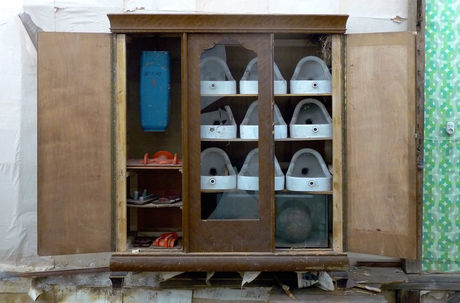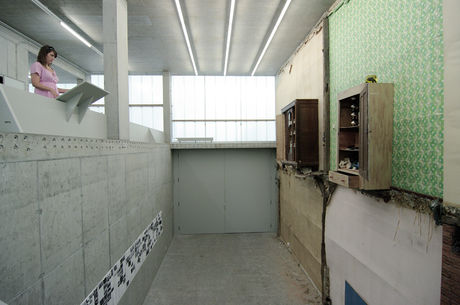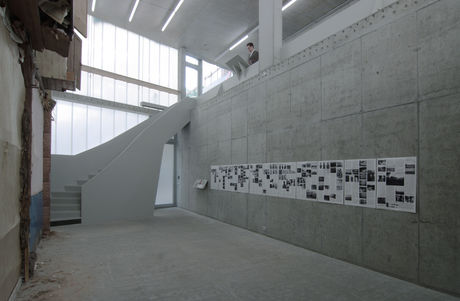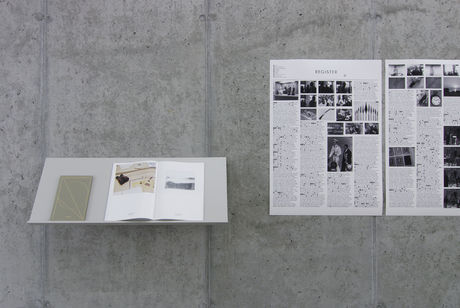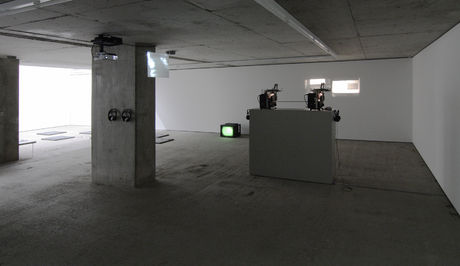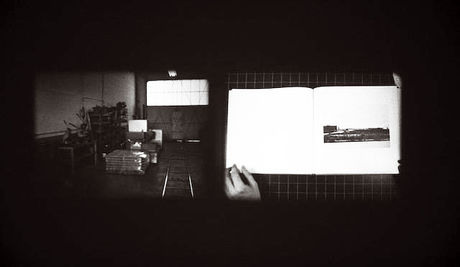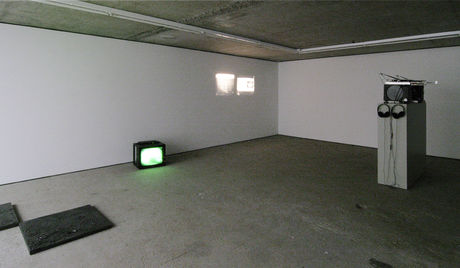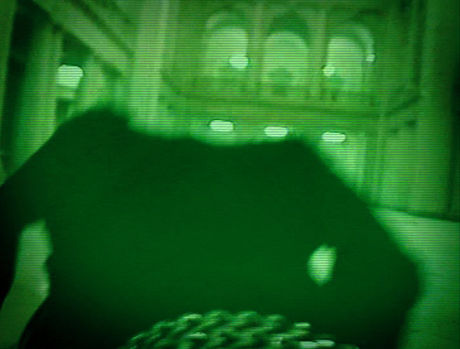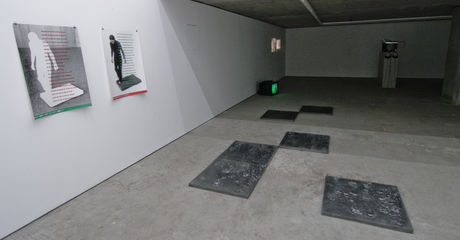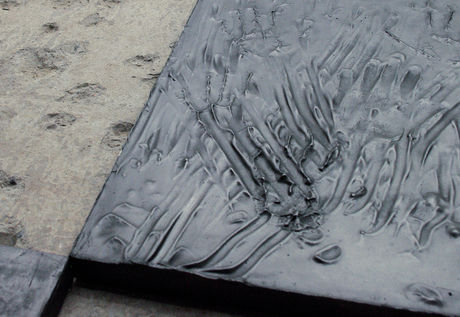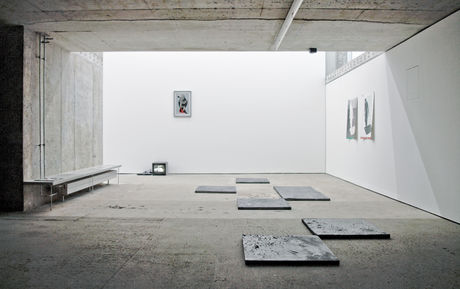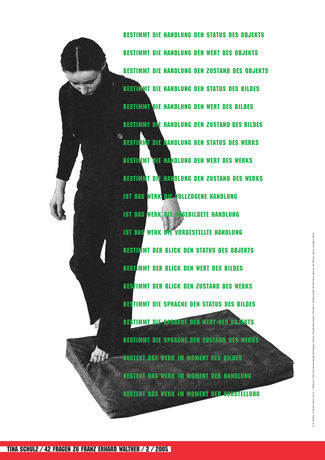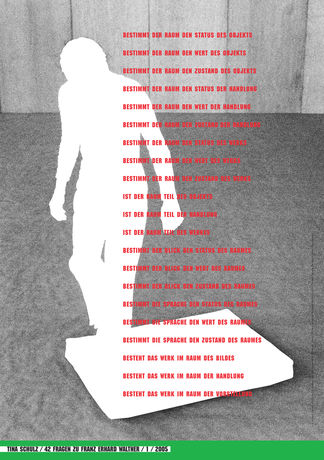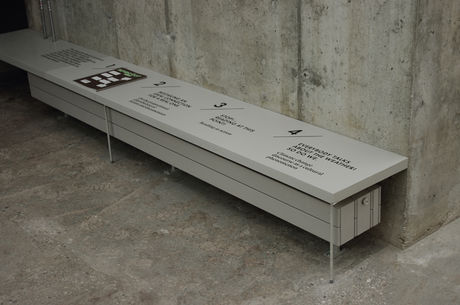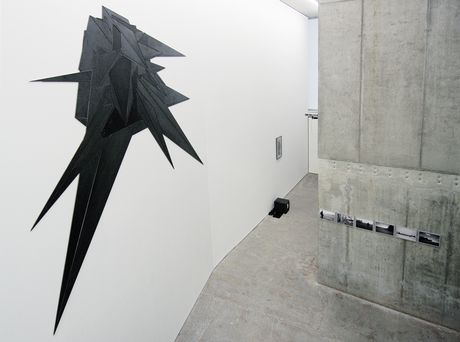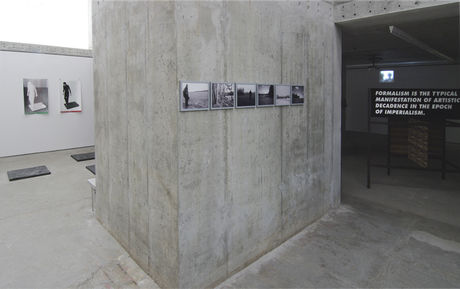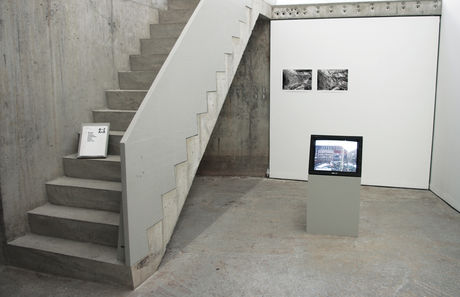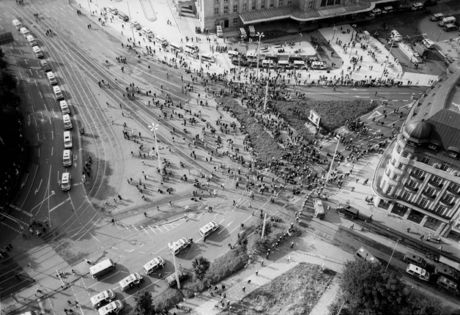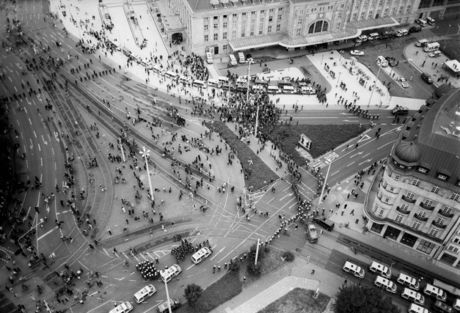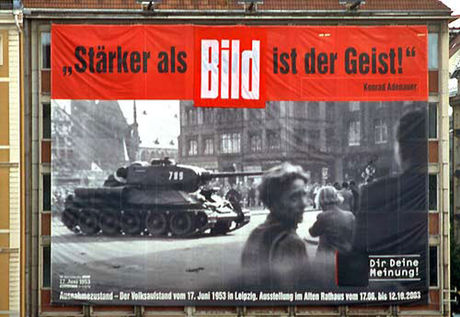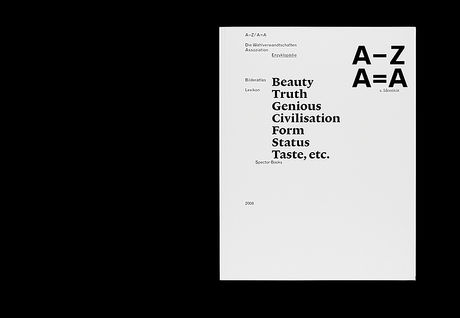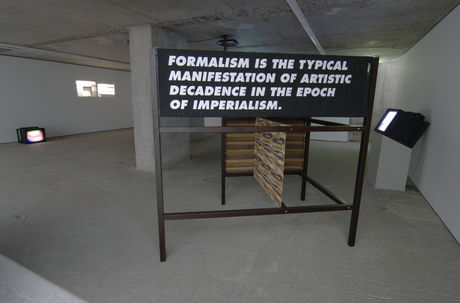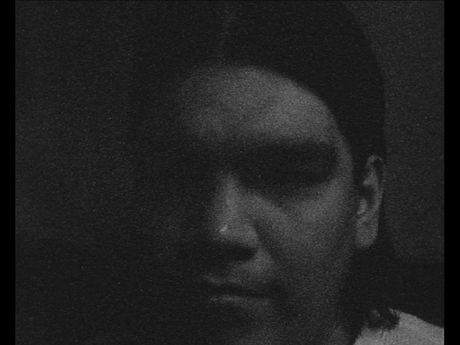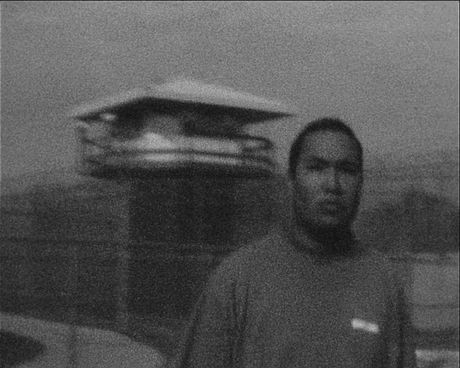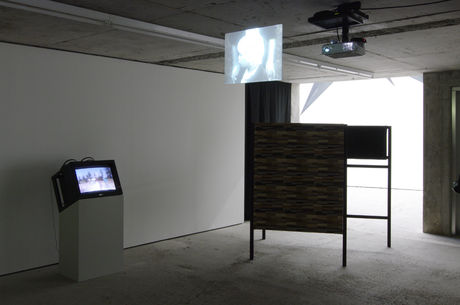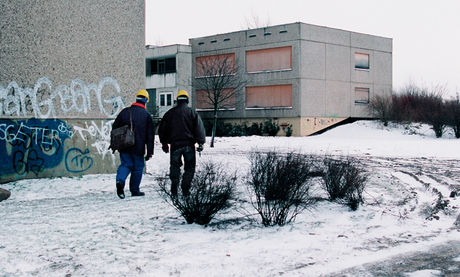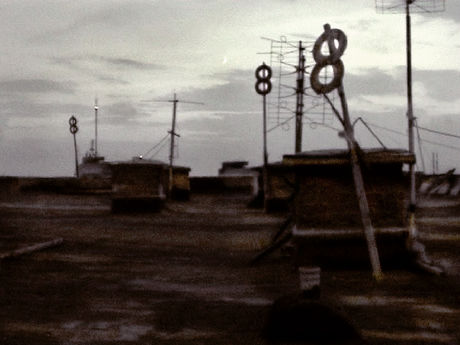Antirepresentationalism 1: Politics of Redescription
Conceptual and Socially oriented Art in Leipzig 1997–2009
Sep 4–Oct 10, 2009
Sep 4–Oct 10, 2009
An exhibition by Alexander Koch and Nikolaus Oberhuber
With Peggy Buth, Jan Caspers/ Anne König/ Jan Wenzel, Chat, Markus Dressen, Famed, Till Gathmann, Lina Grumm, Andreas Grahl, Henriette Grahnert, Mark Hamilton, Bertram Haude, Ramon Haze, Oliver Kossack, Andrea Legiehn, Thomas Lüer, Claudia Annette Maier, Mario Pfeifer, Ulrich Polster, Julius Popp, schau-vogel-schau, Julia Schmidt, Tilo Schulz, Tina Schulz, spector cut+paste, Christoph Weber, Clemens von Wedemeyer, Arthur Zalewski, Tobias Zielony
Introduction
20 years after the fall of the Berlin Wall, we sum up the development of conceptual and socially oriented art in Leipzig since the end of the nineties. Three consecutive exhibitions bring together 28 artists, graphic designers and collectives. We call for a nuanced discussion on the societal change and its artistic resonance in the second decade after Germany’s reunification. For the first time, this chapter of most recent German art is explored in an exhibition series that regroups essential positions and artworks.
The generation we address manages to overcome the dichotomy of political blocs, since it has been experiencing ignorance, ideological stubbornness and genuine solidarity in all camps. Moreover, amidst the drastic social and cultural conversions following the peaceful revolution in Leipzig’s streets, these artists have been sharing the disorientation, the remaining hope and the growing skepticism of many. In 1997, documenta X looked back on the politicization of art since the sixties. Simultaneously, Leipzig-based artists were establishing links to international (Western) artistic developments of the postwar period that had been missing till then. By doing so, they questioned whether Abstraction, Pop Art, Minimalism, Conceptual Art and Institutional Critique could contribute to a modified societal situation. The result is a remarkable variety of artistic vocabularies with a critical stance. Its diversity rejects any notion of a local school or style, even though numerous collaborations in debate and production confirm a great sense of solidarity within this scene over the years.
Three exhibition chapters take the perspective of Richard Rorty’s political philosophy in order to raise key issues of the advanced reunification process that have been occurring in contemporary art from Leipzig. As a pragmatist, Rorty saw no point in separating reality from representation; the world ‘as it really is’ from its ‘mere description’. Rather, he distinguished those descriptions of reality that would inspire and encourage a liberal democracy from others that would not. This is what his “Antirepresentationalism” stands for. It radically politicizes philosophy giving the quest for solidarity priority over the quest for cognition. Since Rorty did not apply this call for solidarity to the visual arts, our exhibition inquires the possible outcome of such an application.
With ANTIREPRESENTATIONALISM we inaugurated our gallery spaces in a new building by Berlin-based architect Brandlhuber at Brunnenstrasse 9 in Berlin-Mitte. Around 5000 visitors saw the show between September 2009 and January 2010.
Part 1: Politics of Redescription
With Peggy Buth, Markus Dressen, Till Gathmann, Lina Grumm, Bertram Haude, Ramon Haze (Andreas Grahl, Holmer Feldmann), Thomas Lüer, Mario Pfeifer, Ulrich Polster, Tilo Schulz, Tina Schulz, spector cut+paste, Christoph Weber, Clemens von Wedemeyer, Arthur Zalewski, Tobias Zielony
ANTIREPRESENTATIONALISM takes up the proposal of the American philosopher Richard Rorty, which states that we should trade in our pursuit of truth and objectivity for an ability to empathize and a passion for social advancement. Rather than wondering whether or not our representations of reality are correct, we should insead examine our sense of solidarity.
POLITICS OF REDESCRIPTION, the first chapter of our exhibition trilogy, assembles works and projects that understand history as a matter of viewpoints and show that viewpoints change. The fact that the past looks different depending on where we stand makes it a political issue. Social cohesion has been redescribed differently ever since the East-West confrontation came to an end in 1989. The debates about a ‚correct‘ view of the past, for example the daily life in the GDR or Socialism‘s fate, often strive for a common viewpoint. But there is no such viewpoint from which the past looks similar to all.
If we were to follow Rorty, we should not see competing interpretations of history as describing the past more or less accurately, but giving expression to the hopes of individuals, communities, nations, that the final words on where they come from and what they may become have not yet been spoken. It is the hope that there is still some latitude for social advancement. The exhibition shows concepts of redescribing historical events and their display as a recurring theme and method in the art from Leipzig in the second decade after the fall of the Berlin wall. The retrospective eye in the exhibited works does not search for a final ground but for other angles of view. It sees that history is being narrated and it tries out variations. It observes the deconstruction of old ideologies and utopias, and their reappearance in new formats. In projecting today‘s questions on yesterday‘s answers it gains clarity from the dissimilarity.
Text: Alexander Koch, Nikolaus Oberhuber. Photos: Alexander Koch
With Peggy Buth, Jan Caspers/ Anne König/ Jan Wenzel, Chat, Markus Dressen, Famed, Till Gathmann, Lina Grumm, Andreas Grahl, Henriette Grahnert, Mark Hamilton, Bertram Haude, Ramon Haze, Oliver Kossack, Andrea Legiehn, Thomas Lüer, Claudia Annette Maier, Mario Pfeifer, Ulrich Polster, Julius Popp, schau-vogel-schau, Julia Schmidt, Tilo Schulz, Tina Schulz, spector cut+paste, Christoph Weber, Clemens von Wedemeyer, Arthur Zalewski, Tobias Zielony
Introduction
20 years after the fall of the Berlin Wall, we sum up the development of conceptual and socially oriented art in Leipzig since the end of the nineties. Three consecutive exhibitions bring together 28 artists, graphic designers and collectives. We call for a nuanced discussion on the societal change and its artistic resonance in the second decade after Germany’s reunification. For the first time, this chapter of most recent German art is explored in an exhibition series that regroups essential positions and artworks.
The generation we address manages to overcome the dichotomy of political blocs, since it has been experiencing ignorance, ideological stubbornness and genuine solidarity in all camps. Moreover, amidst the drastic social and cultural conversions following the peaceful revolution in Leipzig’s streets, these artists have been sharing the disorientation, the remaining hope and the growing skepticism of many. In 1997, documenta X looked back on the politicization of art since the sixties. Simultaneously, Leipzig-based artists were establishing links to international (Western) artistic developments of the postwar period that had been missing till then. By doing so, they questioned whether Abstraction, Pop Art, Minimalism, Conceptual Art and Institutional Critique could contribute to a modified societal situation. The result is a remarkable variety of artistic vocabularies with a critical stance. Its diversity rejects any notion of a local school or style, even though numerous collaborations in debate and production confirm a great sense of solidarity within this scene over the years.
Three exhibition chapters take the perspective of Richard Rorty’s political philosophy in order to raise key issues of the advanced reunification process that have been occurring in contemporary art from Leipzig. As a pragmatist, Rorty saw no point in separating reality from representation; the world ‘as it really is’ from its ‘mere description’. Rather, he distinguished those descriptions of reality that would inspire and encourage a liberal democracy from others that would not. This is what his “Antirepresentationalism” stands for. It radically politicizes philosophy giving the quest for solidarity priority over the quest for cognition. Since Rorty did not apply this call for solidarity to the visual arts, our exhibition inquires the possible outcome of such an application.
With ANTIREPRESENTATIONALISM we inaugurated our gallery spaces in a new building by Berlin-based architect Brandlhuber at Brunnenstrasse 9 in Berlin-Mitte. Around 5000 visitors saw the show between September 2009 and January 2010.
Part 1: Politics of Redescription
With Peggy Buth, Markus Dressen, Till Gathmann, Lina Grumm, Bertram Haude, Ramon Haze (Andreas Grahl, Holmer Feldmann), Thomas Lüer, Mario Pfeifer, Ulrich Polster, Tilo Schulz, Tina Schulz, spector cut+paste, Christoph Weber, Clemens von Wedemeyer, Arthur Zalewski, Tobias Zielony
ANTIREPRESENTATIONALISM takes up the proposal of the American philosopher Richard Rorty, which states that we should trade in our pursuit of truth and objectivity for an ability to empathize and a passion for social advancement. Rather than wondering whether or not our representations of reality are correct, we should insead examine our sense of solidarity.
POLITICS OF REDESCRIPTION, the first chapter of our exhibition trilogy, assembles works and projects that understand history as a matter of viewpoints and show that viewpoints change. The fact that the past looks different depending on where we stand makes it a political issue. Social cohesion has been redescribed differently ever since the East-West confrontation came to an end in 1989. The debates about a ‚correct‘ view of the past, for example the daily life in the GDR or Socialism‘s fate, often strive for a common viewpoint. But there is no such viewpoint from which the past looks similar to all.
If we were to follow Rorty, we should not see competing interpretations of history as describing the past more or less accurately, but giving expression to the hopes of individuals, communities, nations, that the final words on where they come from and what they may become have not yet been spoken. It is the hope that there is still some latitude for social advancement. The exhibition shows concepts of redescribing historical events and their display as a recurring theme and method in the art from Leipzig in the second decade after the fall of the Berlin wall. The retrospective eye in the exhibited works does not search for a final ground but for other angles of view. It sees that history is being narrated and it tries out variations. It observes the deconstruction of old ideologies and utopias, and their reappearance in new formats. In projecting today‘s questions on yesterday‘s answers it gains clarity from the dissimilarity.
Text: Alexander Koch, Nikolaus Oberhuber. Photos: Alexander Koch
